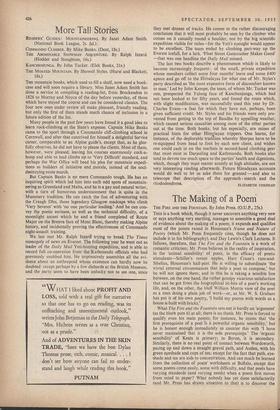More Tall Stories
READERS' GUIDES: MOUNTAINEERING. By Janet Adam Smith. (National Book League, 2s. 6d.) COMMANDO CLIMBER. By Mike Banks. (Dent, 18s.) KANCHENJUNGA. By John Tucker. (Elek Books, 21s.) THE MOATED MOUNTAIN. By Showell Styles. (Hurst and Blackett, 18s.) THE mountain books, which used to fill a shelf, now need a book- case and will soon require a library. Miss Janet Adam Smith has done a service in compiling a reading-list, frOm Brockendon in 1828 to Murray and Noyce of the day before yesterday, of those which have stayed the course and can be considered classics. The four new ones under review all make pleasant, friendly reading, but only the first of them stands much chance of inclusion in a future edition of the list.
Many people in the past few years have found it a good idea to learn rock-climbing at the State's expense. Captain Mike Banks came to the sport through a Commando cliff-climbing school in Cornwall, and after that contrived for himself a delightful Service career, comparable to an Alpine guide's, except that, as he glee- fully observes, he did not have to please the clients. Most of them, however, were pleased, leaving his courses enormously cock-a- hoop and able to lead climbs up to 'Very Difficult' standard, and perhaps the War Office will heed his plea for mountain expedi- tions as builders of initiative and morale, instead of the soul- destroying route march.
But Captain Banks is no mere Commando tough. He has an inquiring spirit which led him into such odd spots of mountain- eering as Greenland and Malta, and he is a gay and natural writer, with a turn of humorous understatement that is quite in the Mummery tradition. He can catch the fun of adventuring with the Creagh Dhu, those legendary Glasgow madcaps who climb 'Very Severes' with `no one particular leading.' And he can con- vey the poetic eeriness, as well as the technical difficulty, of a moonlight ascent which he and a friend completed of Route Major on the Brenva face of Mont Blanc, thereby making Alpine history, and incidentally proving the effectiveness of Commando night-assault training.
We last met Mr. Ralph Izzard trying to break The Times monopoly of news on Everest. The following year he went out as leader of the Daily Mail Yeti-hunting expedition, and is able to record full co-operation from the Kathmandu officials who had previously snubbed him. He impressively assembles all the evi- dence about an anthropoid whose existence can hardly now be doubted except perhaps by a few diehards at the British Museum, and the party seem to have been unlucky not to see one, since they met dozens of tracks. He comes to the rather discouraging conclusion that it will most probably be seen by the climber who comes on it casually round a boulder, not by the big scientific expedition visible for miles—for the Yeti's eyesight would appear to be excellent. The team ended by climbing part-way up the Everest icefall, for a lark. 'Fleet Street Gatecrasher Makes Good' —that was one headline the Daily Mail missed.
The last two books describe a phenomenon which is likely to become increasingly frequent : of the small, private expedition whose members collect some four months' leave and some £400 apiece and go off to the Himalayas for what one of Mr. Styles's party described as 'the most expensive form of discomfort known to man.' Led by John Kempe, the team, of whom Mr. Tucker was one, prospected the Yalung face of Kanchenjunga, which had not been looked at for fifty years, and found the route which, with slight modification, was successfully used this year by Dr. Charles Evans—a feat for which they have not, perhaps, been given sufficient credit. Mr. Styles and his friends were only pre- vented from getting to the top of Baudha by appalling weather, which caused serious casualties among most of the other parties out at the time. Both books, but his especially, are mines of practical hints for other Him;layan trippers. One learns, for instance, of the deplorable tradilion whereby Sherpas have to be re-equipped from head to foot by each new client, and wishes one could cash in on the markets in second-hand climbing gear that must exist in Darjeeling and Kathmandu. Both books also tend to devote too much space to the parties' health and digestions, which, though they must matter acutely at high altitudes, are not very interesting reading afterwards. Future Himalayan accounts would do well to let us take them for granted — and also to telescope that description of the approach - march and the


































 Previous page
Previous page